A Regional-Scale Landslide Early Warning System Based on the Sequential Evaluation Method: Development and Performance Analysis
Abstract
:1. Introduction
2. Landslide Early Warning System for Busan: SEM-LEWS
2.1. Principles of Landslide Early Warning System: Sequential Evaluation Method
2.2. Development and Structure of SEM-LEWS
3. Performance Analysis of SEM-LEWS Based on the Simulation Results of 8-Year Histories
3.1. Study Framework
3.2. Establishment of Historical Landslide Database Using Indirect Field-Checks
4. Results and Discussion
4.1. Analysis of Prediction Statistics of Historical Landslide Data
4.2. Temporal Performance Analysis
4.3. Potential Limitations and Future Study
5. Conclusions
- According to real-time recorded or forecasted rainfall data, the developed system determines five warning level classes by consecutively applying three different evaluation stages: statistical, physically based, and geomorphological evaluations.
- Each of the five warning level phases has its own interpretations derived from the theoretical backgrounds of the evaluation thresholds. Most notably, the highest warning level class, “Emergency”, was defined to discriminatively issue warnings regarding potential debris flow initiations.
- The system exhibits nowcasting and forecasting capabilities and is able to generate two types of early warning level maps depending on the management interest: specific areal warning maps or administrative division warning maps.
- As a result of the prediction statistics analysis, 81% (150/186) of historical slope failure data and 86% (31/36) of historical debris flow data were correctly predicted by the “Alert” and “Emergency” levels, respectively.
- Four slope-failure events and five debris-flow events were classified as missed-warning errors, although these were determined as minor local failures of artificial slopes and small-scale erosive soil flows.
- As a result of analyzing temporal performance in a study region that is characterized by almost homogeneous rainfall, geo-properties, and hence the initiation timing of warning levels, miscellaneous quantitative information associated to the timing of early warnings was derived to provide answers for pragmatic questions including: “How much lead time is given?”, “What is the duration of the issued early warning?”, and “What is the probability of a landslide occurring given that an early warning has been issued?”
- During the study period, the system generated a total of 30 warning events. Among the events, five warning events were cases that involved high-class warning levels, and landslides occurred in four out of these five warning events. It was inferred that there exist critical amounts of rainfall that serve as boundaries for triggering landslide events.
Author Contributions
Funding
Acknowledgments
Conflicts of Interest
References
- Froude, M.J.; Petley, D. Global fatal landslide occurrence from 2004 to 2016. Nat. Hazards Earth Syst. Sci. 2018, 18, 2161–2181. [Google Scholar] [CrossRef] [Green Version]
- Haque, U.; Da Silva, P.F.; Devoli, G.; Pilz, J.; Zhao, B.; Khaloua, A.; Wilopo, W.; Andersen, P.; Lu, P.; Lee, J.; et al. The human cost of global warming: Deadly landslides and their triggers (1995–2014). Sci. Total Environ. 2019, 682, 67–684. [Google Scholar] [CrossRef] [PubMed]
- Petley, D. Global patterns of loss of life from landslides. Geology 2012, 40, 927–930. [Google Scholar] [CrossRef]
- Sultana, N. Analysis of landslide-induced fatalities and injuries in Bangladesh: 2000–2018. Cogent Soc. Sci. 2020, 6, 1737402. [Google Scholar] [CrossRef]
- Korea Forest Service. 2013 Main Business Plan Details; Korea Forest Service: Daejeon, Korea, 2013. [Google Scholar]
- National Institute for Disaster Prevention. The Field Survey Report of Damages Caused by the Typhoon RUSA in 2002; Ministry of Government Administration and Home Affairs: Seoul, Korea, 2002; p. 257.
- Petley, D.N. On the impact of climate change and population growth on the occurrence of fatal landslides in South, East and SE Asia. Q. J. Eng. Geol. Hydrogeol. 2010, 43, 487–496. [Google Scholar] [CrossRef]
- Guzzetti, F.; Gariano, S.L.; Peruccacci, S.; Brunetti, M.T.; Marchesini, I.; Rossi, M.; Melillo, M. Geographical landslide early warning systems. Earth-Sci. Rev. 2020, 200, 102973. [Google Scholar] [CrossRef]
- Piciullo, L.; Calvello, M.; Cepeda, J.M. Territorial early warning systems for rainfall-induced landslides. Earth-Sci. Rev. 2018, 179, 228–247. [Google Scholar] [CrossRef]
- Jakob, M.; Owen, T.; Simpson, T. A regional real-time debris-flow warning system for the District of North Vancouver, Canada. Landslides 2012, 9, 165–178. [Google Scholar] [CrossRef]
- Baum, R.L.; Godt, J.W. Early warning of rainfall-induced shallow landslides and debris flows in the USA. Landslides 2010, 7, 259–272. [Google Scholar] [CrossRef]
- Calvello, M.; d’Orsi, R.N.; Piciullo, L.; Paes, N.; Magalhaes, M.; Lacerda, W.A. The Rio de Janeiro early warning system for rainfall-induced landslides: Analysis of performance for the years 2010–2013. Int. J. Disaster Risk Reduct. 2015, 12, 3–15. [Google Scholar] [CrossRef]
- Wong, A.C.W.; Ting, S.M.; Shiu, Y.K.; Ho, K.K.S. Latest developments of Hong Kong’s landslip warning system. In Landslide Science for a Safer Geoenvironment; Springer: Cham, Switzerland, 2014; pp. 613–618. [Google Scholar]
- Ponziani, F.; Berni, N.; Stelluti, M.; Zauri, R.; Pandolfo, C.; Brocca, L.; Moramarco, T.; Salciarini, D.; Tamagnini, C. Landwarn: An operative early warning system for landslides forecasting based on rainfall thresholds and soil moisture. In Landslide Science and Practice; Springer: Berlin/Heidelberg, Germany, 2013; pp. 627–634. [Google Scholar]
- Segoni, S.; Battistini, A.; Rossi, G.; Rosi, A.; Lagomarsino, D.; Catani, F.; Moretti, S. An operational landslide early warning system at regional scale based on space-time-variable rainfall thresholds. Nat. Hazards Earth Syst. Sci. 2015, 15, 853–861. [Google Scholar] [CrossRef] [Green Version]
- Segoni, S.; Rosi, A.; Fanti, R.; Gallucci, A.; Monni, A.; Casagli, N. A regional-scale landslide warning system based on 20 years of operational experience. Water 2018, 10, 1297. [Google Scholar] [CrossRef] [Green Version]
- Colleuille, H.; Haugen, L.E.; Beldring, S. A forecast analysis tool for extreme hydrological conditions in Norway. In Poster Presented at the Sixth World FRIEND Conference, Marocco; UNESCO: Paris, France, 2010. [Google Scholar]
- Osanai, N.; Shimizu, T.; Kuramoto, K.; Kojima, S.; Noro, T. Japanese early-warning for debris flows and slope failures using rainfall indices with Radial Basis Function Network. Landslides 2010, 7, 325–338. [Google Scholar] [CrossRef]
- Rossi, M.; Peruccacci, S.; Brunetti, M.T.; Marchesini, I.; Luciani, S.; Ardizzone, F.; Balducci, V.; Bianchi, C.; Cardinali, M.; Fiorucci, F.; et al. SANF: National warning system for rainfall-induced landslides in Italy. Landslides Eng. Slopes Prot. Soc. Through Improv. Underst. 2012, 2, 1895–1899. [Google Scholar]
- Peruccacci, S.; Brunetti, M.; Gariano, S.; Melillo, M.; Rossi, M.; Guzzetti, F. Rainfall thresholds for possible landslide occurrence in Italy. Geomorphology 2017, 290. [Google Scholar] [CrossRef]
- Park, J.Y.; Lee, S.R.; Lee, D.H.; Kim, Y.T.; Lee, J.S. A regional-scale landslide early warning methodology applying statistical and physically based approaches in sequence. Eng. Geol. 2019, 260, 105193. [Google Scholar] [CrossRef]
- Wilks, D. Statistical Methods in the Atmospheric Sciences, 2nd ed.; International Geophysical Series; Academic Press: Cambridge, MA, USA, 1995; Volume 59, p. 464. [Google Scholar] [CrossRef]
- Calvello, M.; Piciullo, L. Assessing the performance of regional landslide early warning models: The EDuMaP method. Nat. Hazards Earth Syst. Sci. 2016, 16, 103–122. [Google Scholar] [CrossRef] [Green Version]
- Gariano, S.L.; Brunetti, M.T.; Iovine, G.; Melillo, M.; Peruccacci, S.; Terranova, O.; Vennari, C.; Guzzetti, F. Calibration and validation of rainfall thresholds for shallow landslide forecasting in Sicily, southern Italy. Geomorphology 2015, 228, 653–665. [Google Scholar] [CrossRef]
- Martelloni, G.; Segoni, S.; Fanti, R.; Catani, F. Rainfall thresholds for the forecasting of landslide occurrence at regional scale. Landslides 2012, 9, 485–495. [Google Scholar] [CrossRef] [Green Version]
- Han, J.G. The characteristics analysis of landslides and rainfall at Pusan area. J. Korean Soc. Environ. Restor. Technol. 2001, 4, 24–31. [Google Scholar]
- Kim, J.M.; Choi, J.C. Study on landslide hazard possibility for Mt. Hwangryeong in Busan Metropolitan city using the infinite slope model. J. Eng. Geol. 2016, 26, 413–422. [Google Scholar] [CrossRef]
- Lee, S.G. A Study on potential risk of landslide in Pusan. J. Korean Soc. Environ. Restor. Technol. 1999, 2, 9–23. [Google Scholar]
- Ryu, J.H.; Seo, S.H.; Kim, Y. A case study for landslide of Busan-Gyeongnam area occurred in 2014. J. Korean Soc. Hazard. Mitig 2015, 15, 143–151. [Google Scholar] [CrossRef]
- Park, Y.; Kim, J.; Jo, D.J.; Kim, S. Urban mud and debris flow disaster vulnerability assessment associated with landslide hazard map: Application to Busan, Korea. J. Korean Soc. Hazard. Mitig. 2015, 15, 283–289. [Google Scholar] [CrossRef] [Green Version]
- Pradhan, A.M.S.; Lee, S.R.; Kim, Y.T. A shallow slide prediction model combining rainfall threshold warnings and shallow slide susceptibility in Busan, Korea. Landslides 2019, 16, 647–659. [Google Scholar] [CrossRef]
- Lee, C.; Kim, D.; Woo, C.; Kim, Y.S.; Seo, J.; Kwon, H. Construction and operation of the national landslide forecast system using soil water index in Republic of Korea. J. Korean Soc. Hazard. Mitig. 2015, 15, 213–221. [Google Scholar] [CrossRef] [Green Version]
- Seo, J.; Jeong, I.; Park, Y.; Kim, J.; Lim, J. Development of open platform for enhancing disaster risk management. In Proceedings of the 2nd International Conference on Information and Communication Technologies for Disaster Management (ICT-DM), Rennes, France, 30 November–2 December 2015; IEEE: New York, NY, USA, 2015; pp. 287–288. [Google Scholar]
- Naver Map. Online Map Service for South Korea. Available online: https://map.naver.com/ (accessed on 29 June 2020).
- Kakao Map. Online Map Service for South Korea. Available online: https://map.kakao.com/ (accessed on 29 June 2020).
- Chleborad, A.F.; Baum, R.L.; Godt, J.W.; Powers, P.S. A prototype system for forecasting landslides in the Seattle, Washington, area. Rev. Eng. Geol. 2008, 20, 103–120. [Google Scholar]
- Finlay, P.J.; Fell, R.; Maguire, P.K. The relationship between the probability of landslide occurrence and rainfall. Can. Geotech. J. 1997, 34, 811–824. [Google Scholar] [CrossRef]
- Segoni, S.; Martelloni, G.; Lagomarsino, D.; Fanti, R.; Catani, F. An operational warning system for the forecasting of landslide occurrence at regional scale. In Landslide Science and Practice; Springer: Berlin/Heidelberg, Germany, 2013; pp. 611–617. [Google Scholar]
- Brand, E.W. Landslides in Southeast Asia: A state of the art report. In Proceedings of the 4th International Symposium on Landslides, Toronto, ON, Canada, 17 September 1984; BiTech Publishers: Vancouver, BC, Canada, 1984; Volume 1, pp. 17–59. [Google Scholar]
- Brunetti, M.T.; Peruccacci, S.; Rossi, M.; Luciani, S.; Valigi, D.; Guzzetti, F. Rainfall thresholds for the possible occurrence of landslides in Italy. Nat. Hazards Earth Syst. Sci. 2010, 10, 447–458. [Google Scholar] [CrossRef]
- Park, J.Y. Development of a Regional-Scale Landslide Early Warning System Applying Statistical and Physically Based Evaluation Approaches in Sequence. Ph.D. Thesis, Korea Advanced Institute of Science and Technology, Daejeon, Korea, 2019; p. 106. [Google Scholar]
- Corominas, J.; Mavrouli, J. Living with landslide risk in europe: Assessment, effects of global change, and risk management strategies. In Documento Técnico; 7th Framework Programme Cooperafion Theme; SafeLand: Stockholm, Sweden, 2011; p. 6. [Google Scholar]
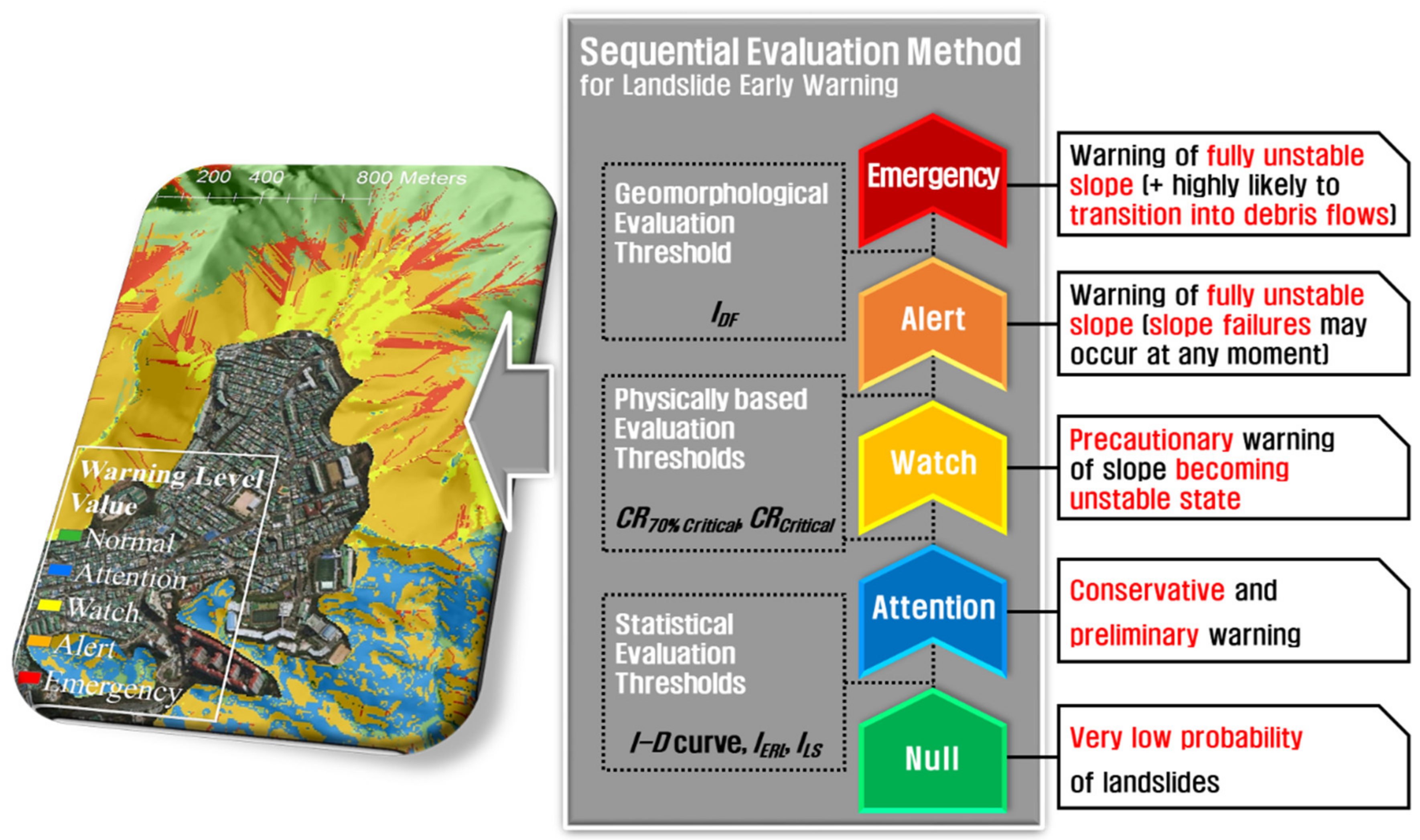
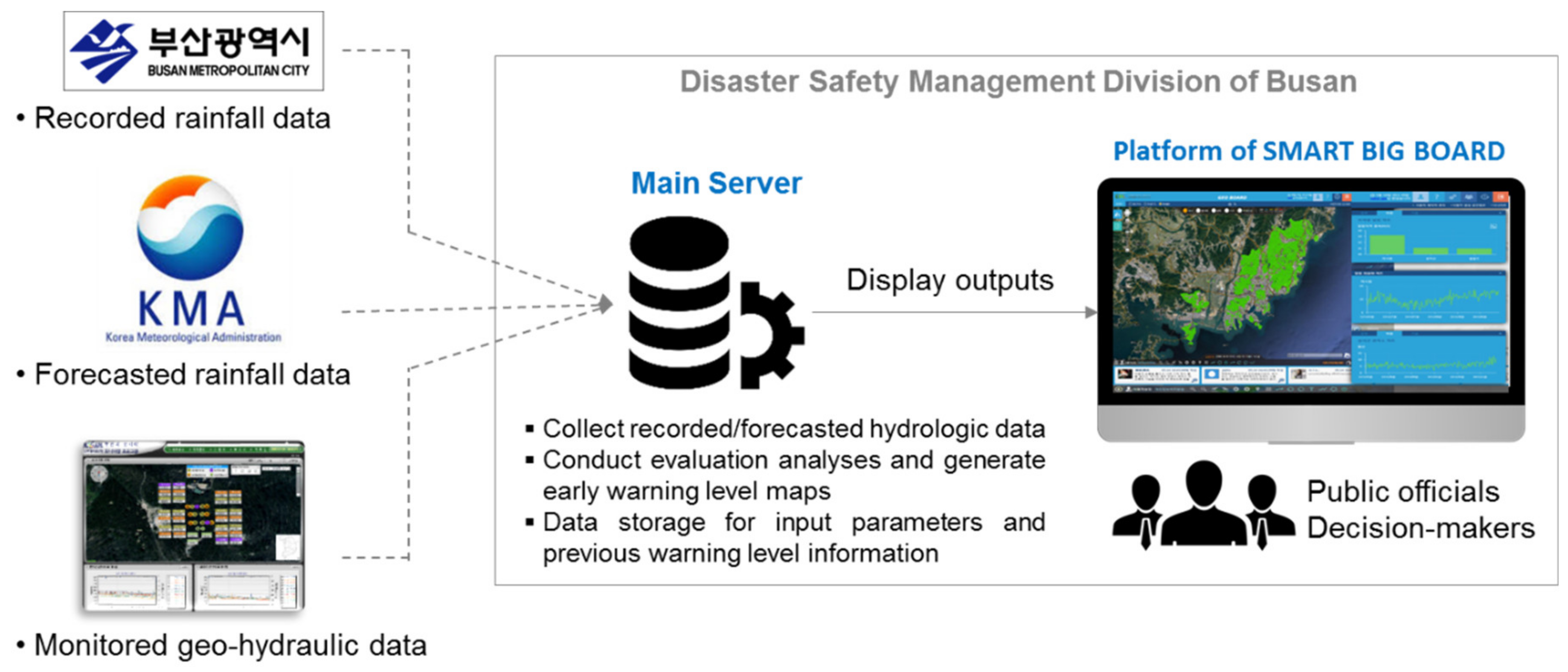
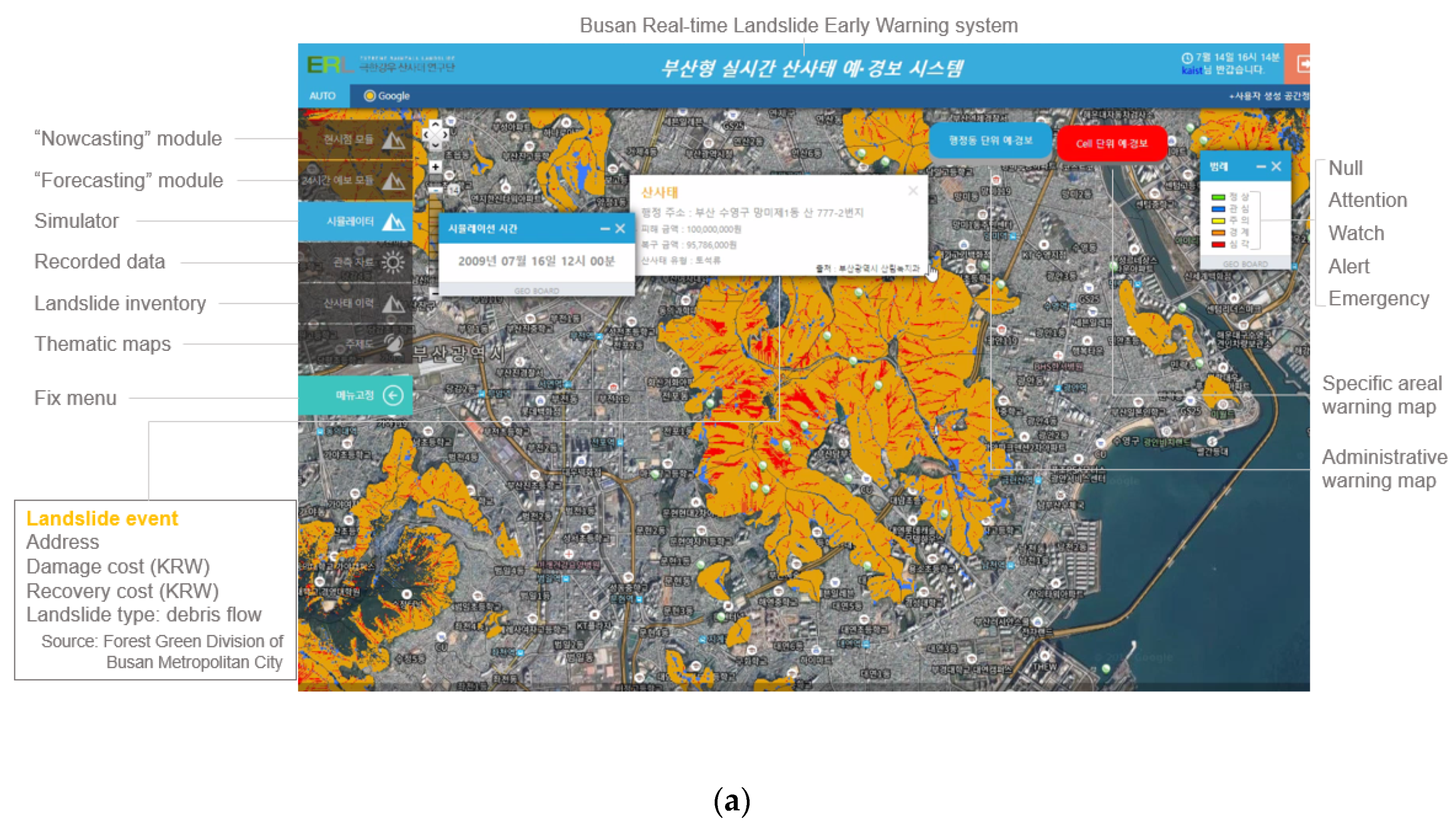
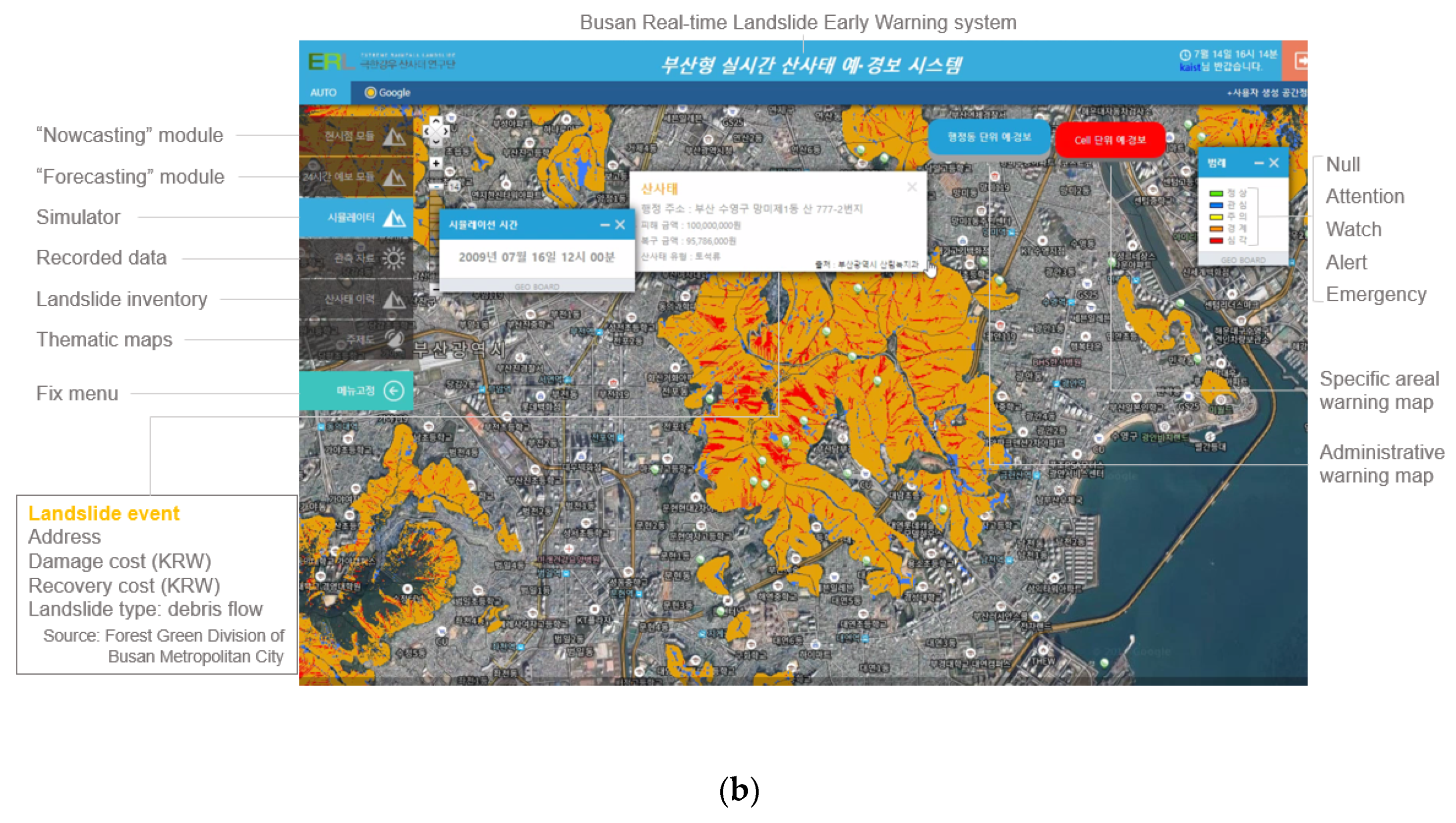
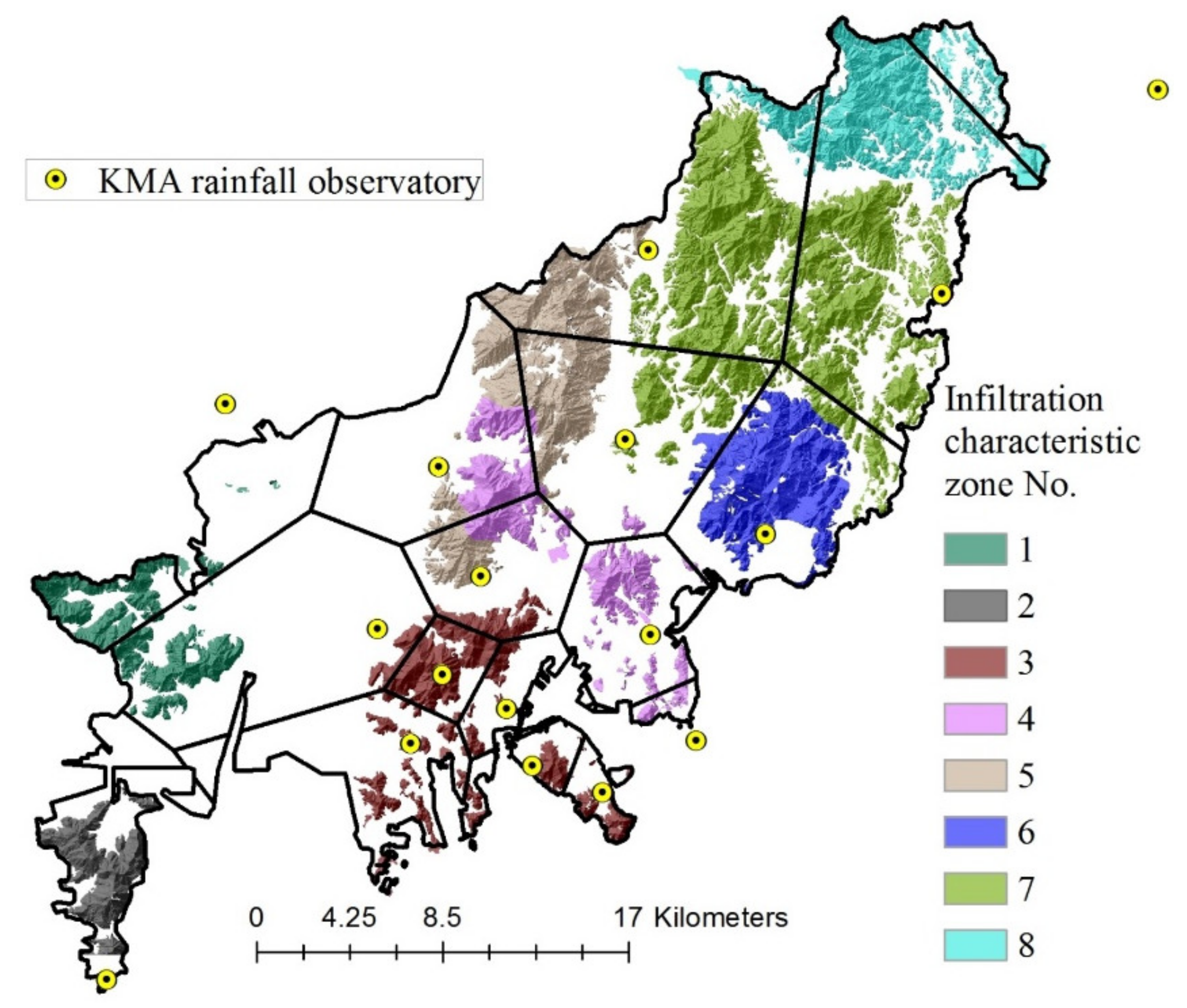
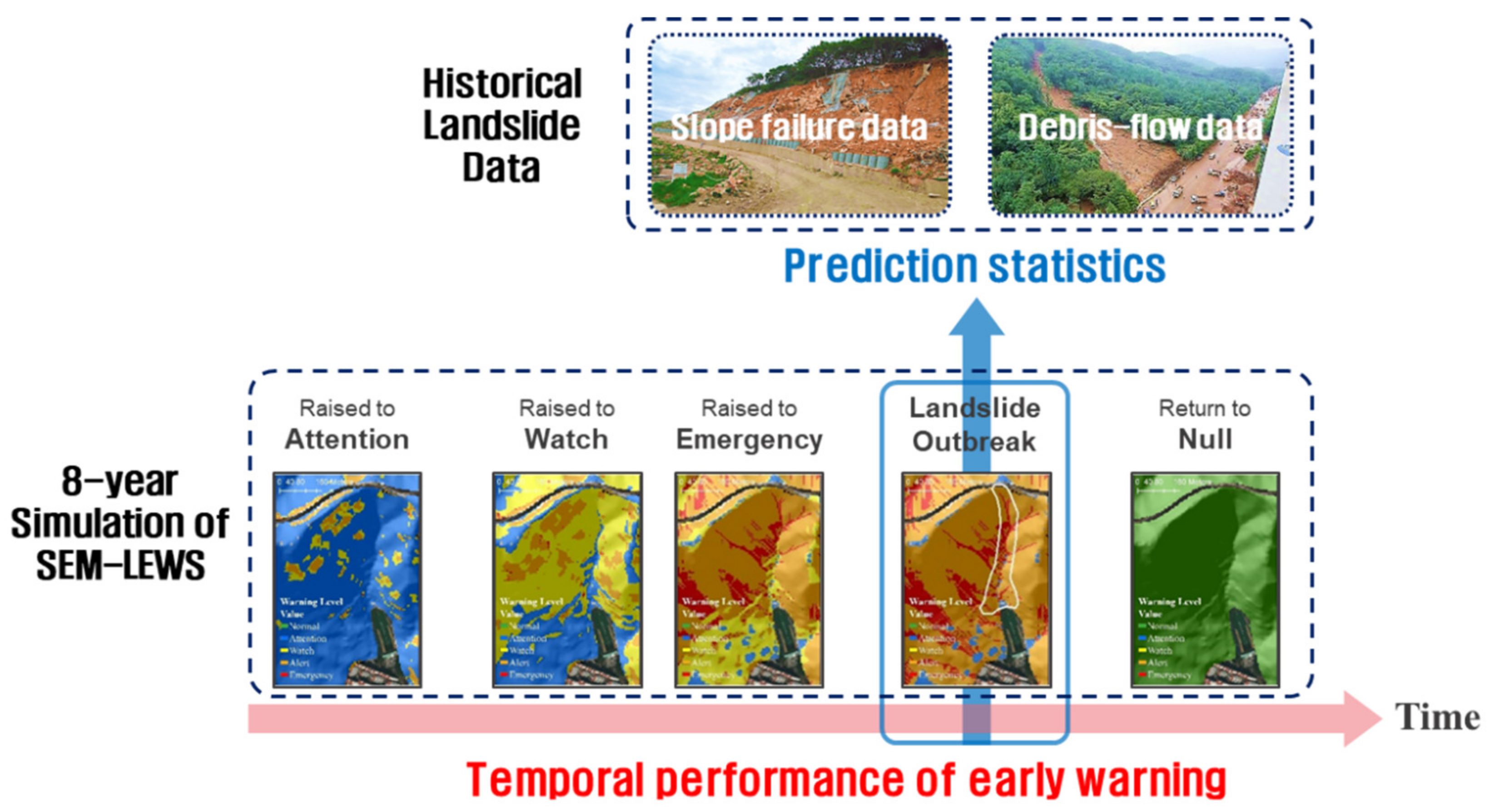
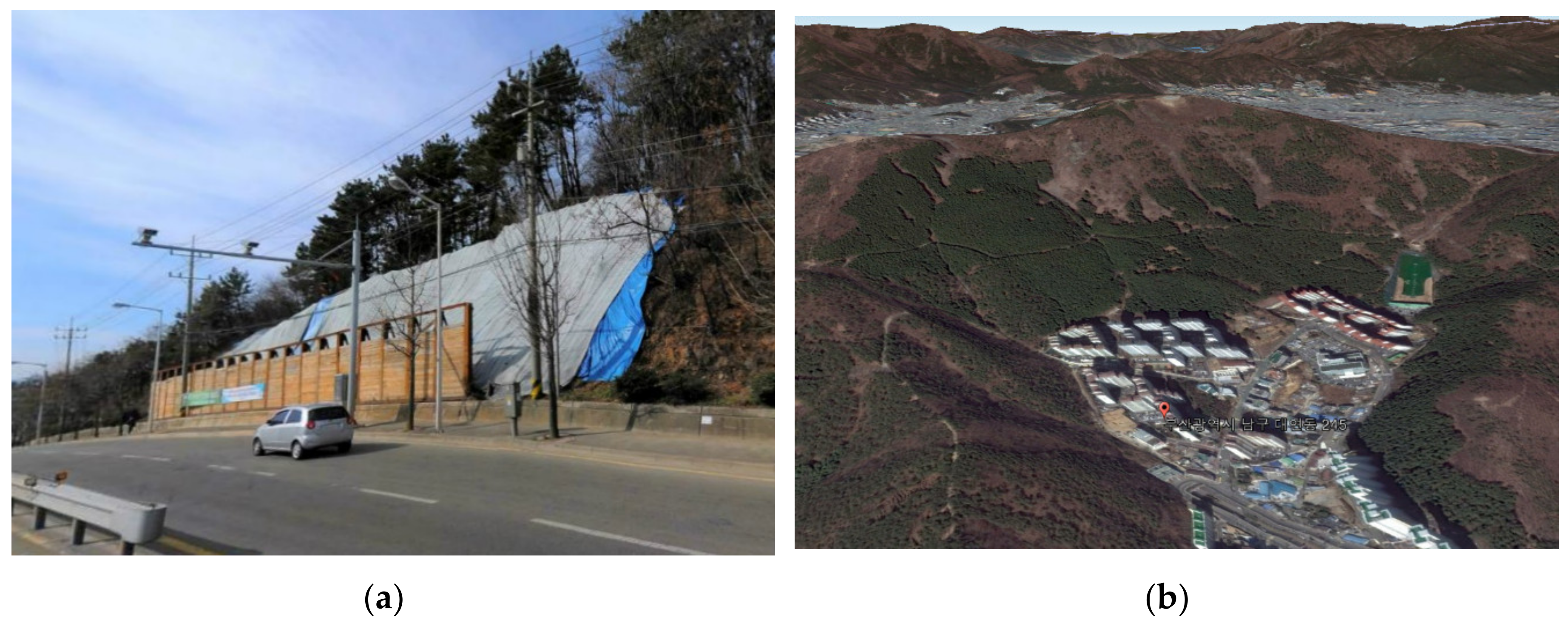
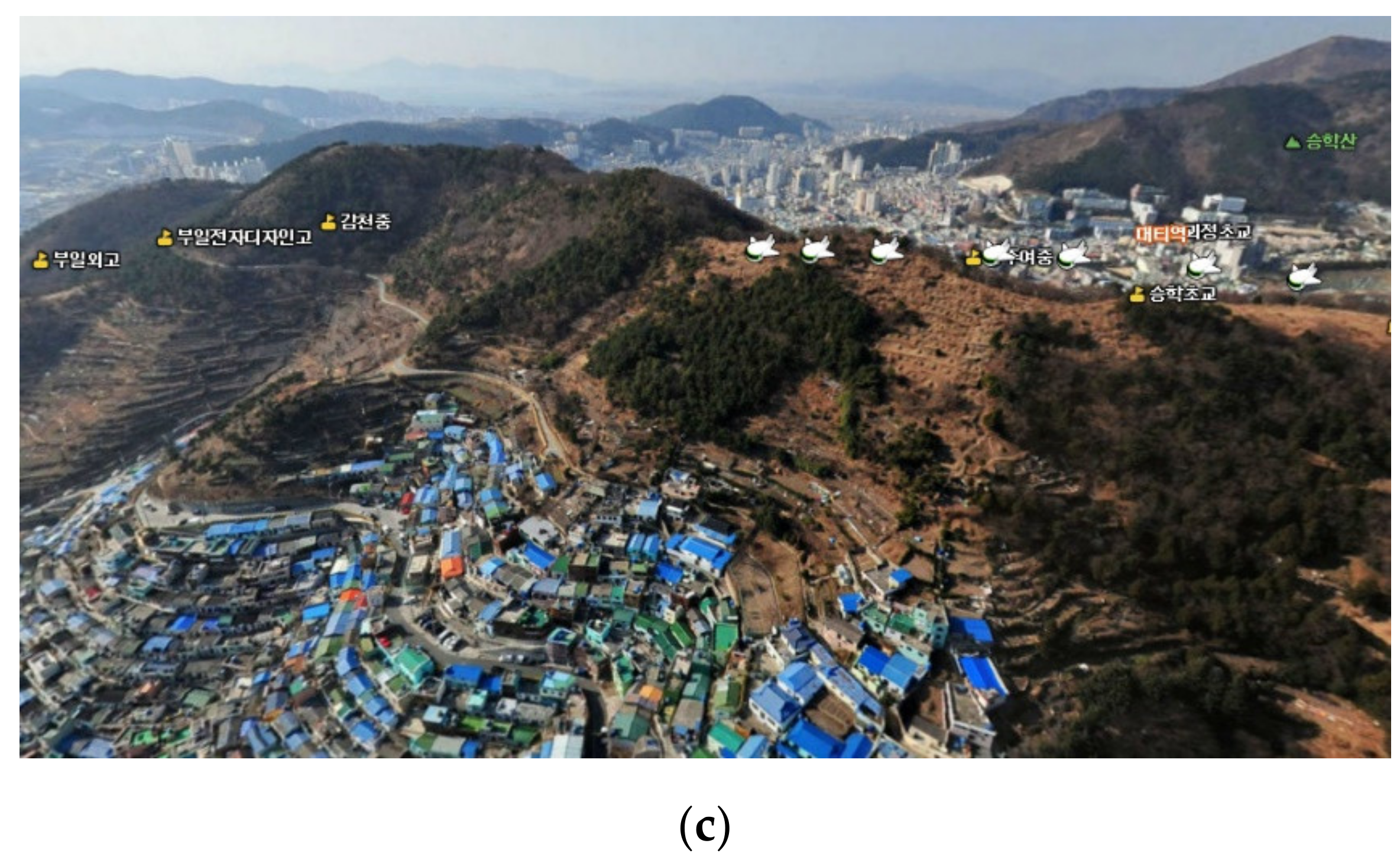

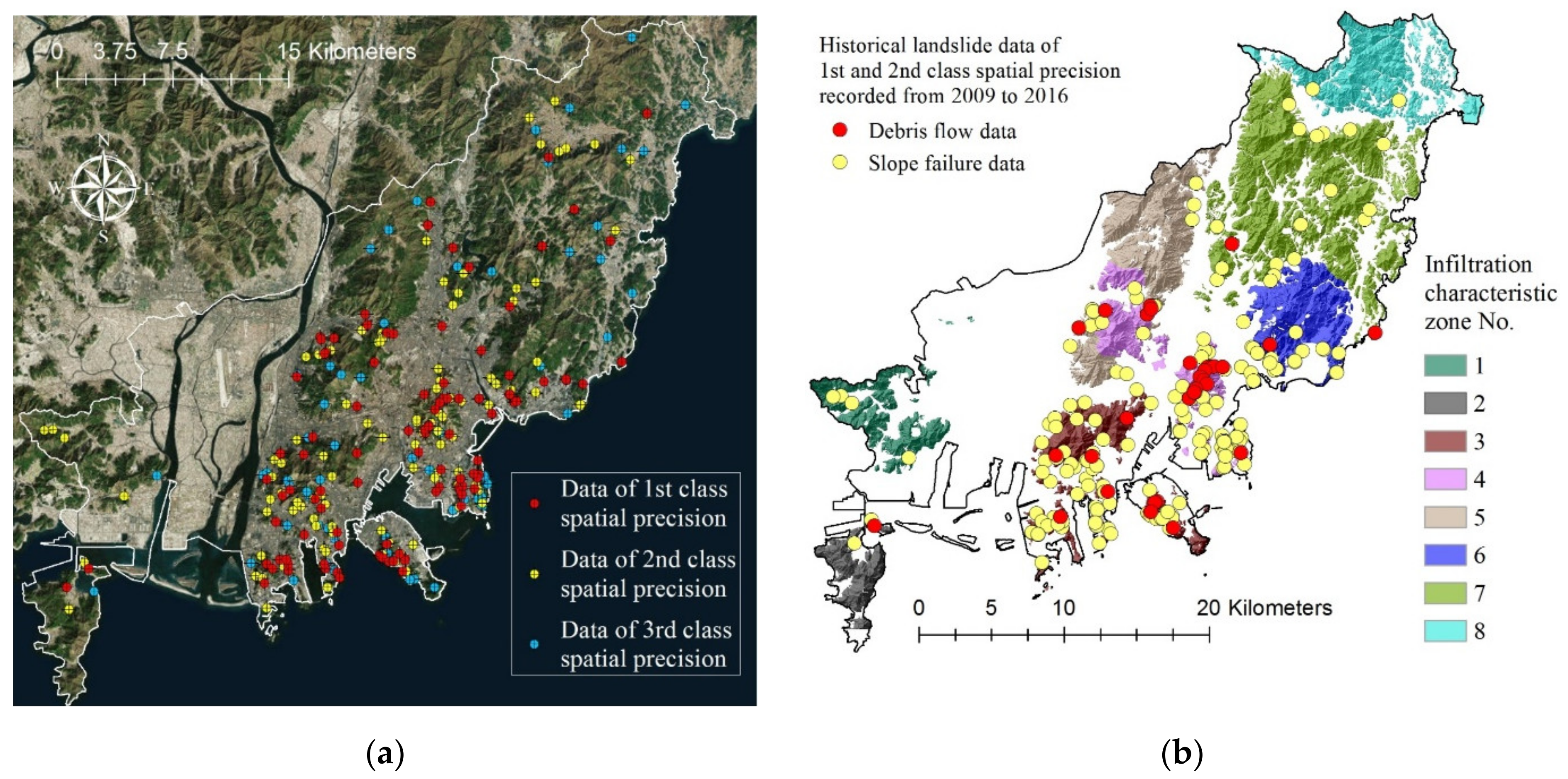


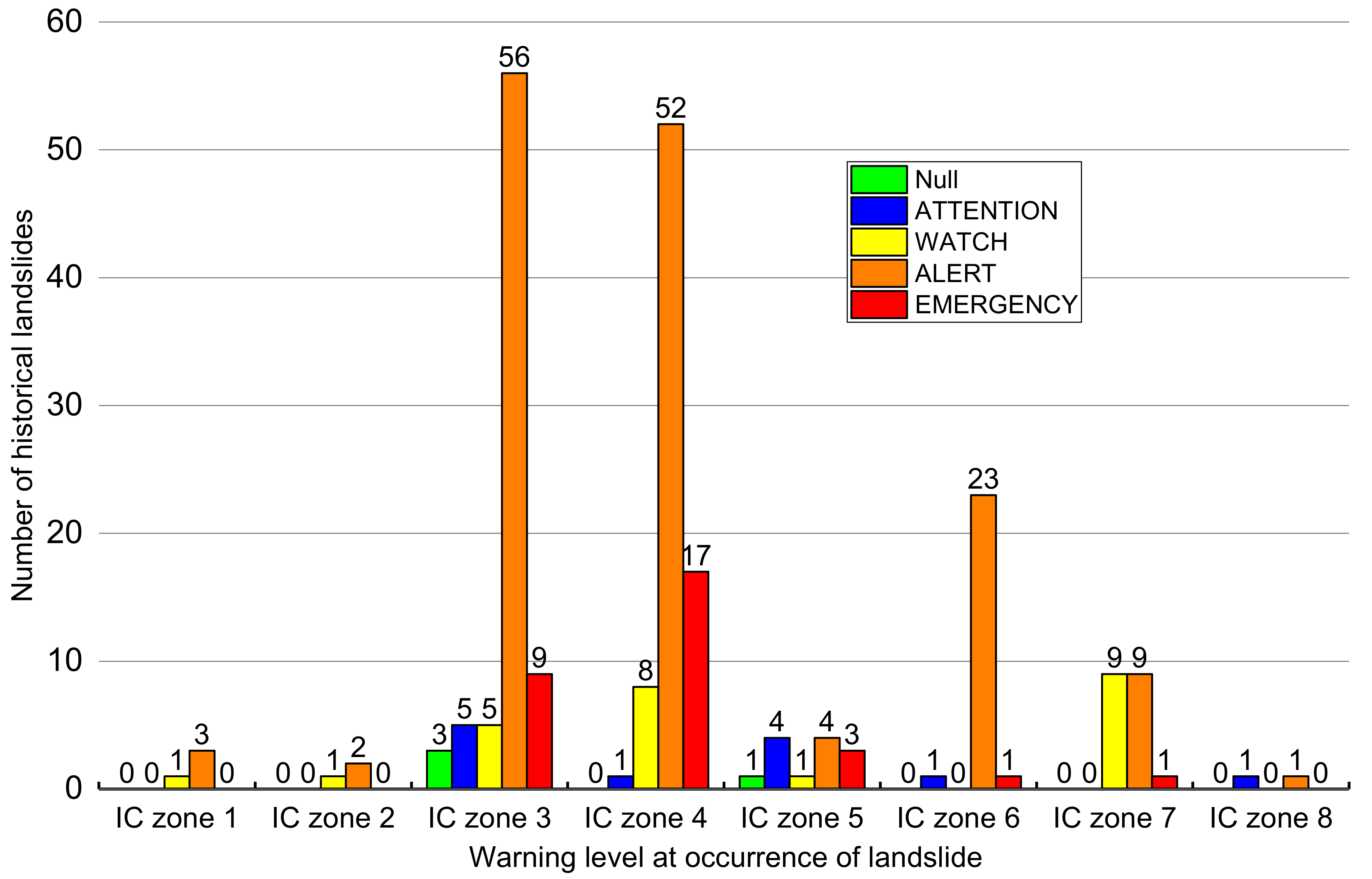

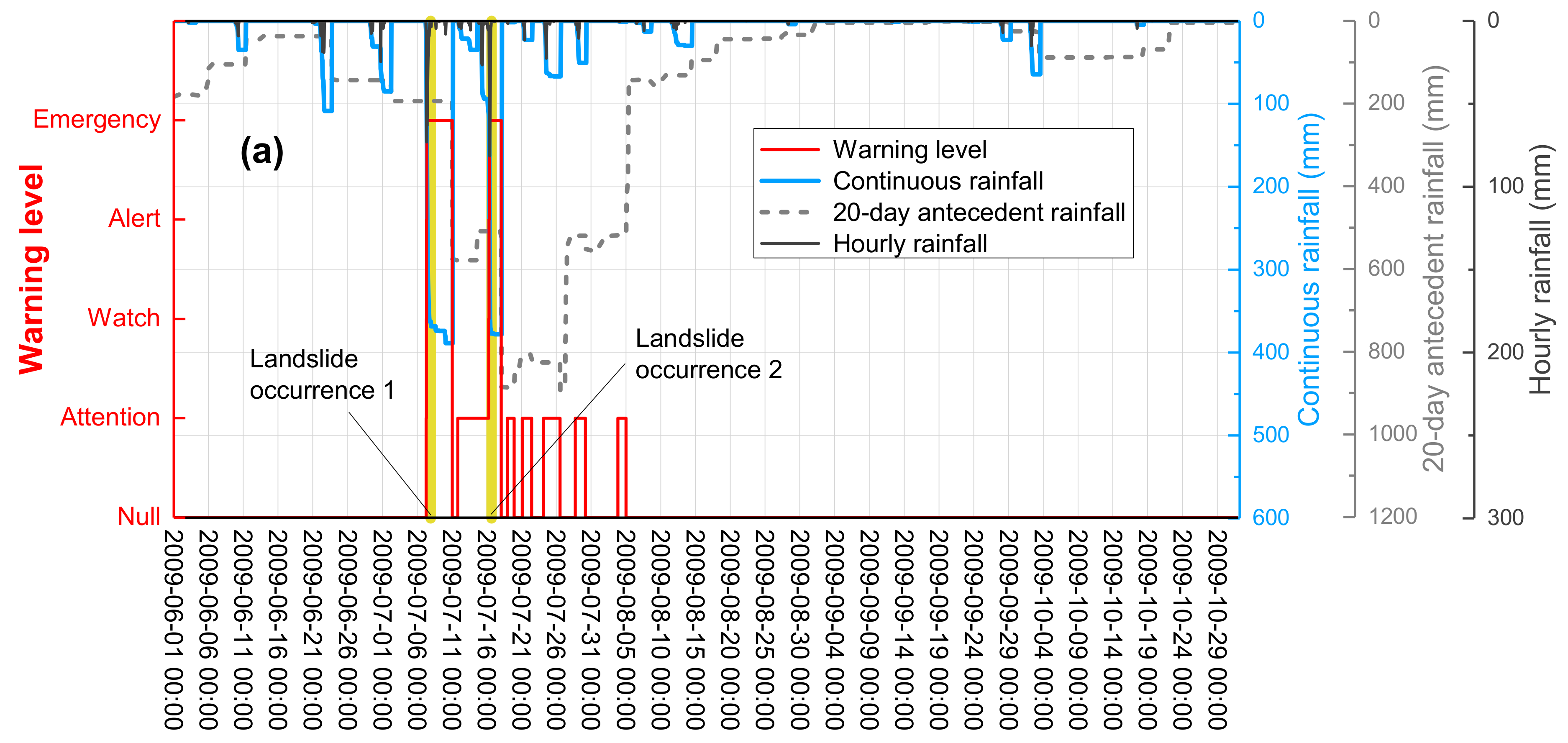
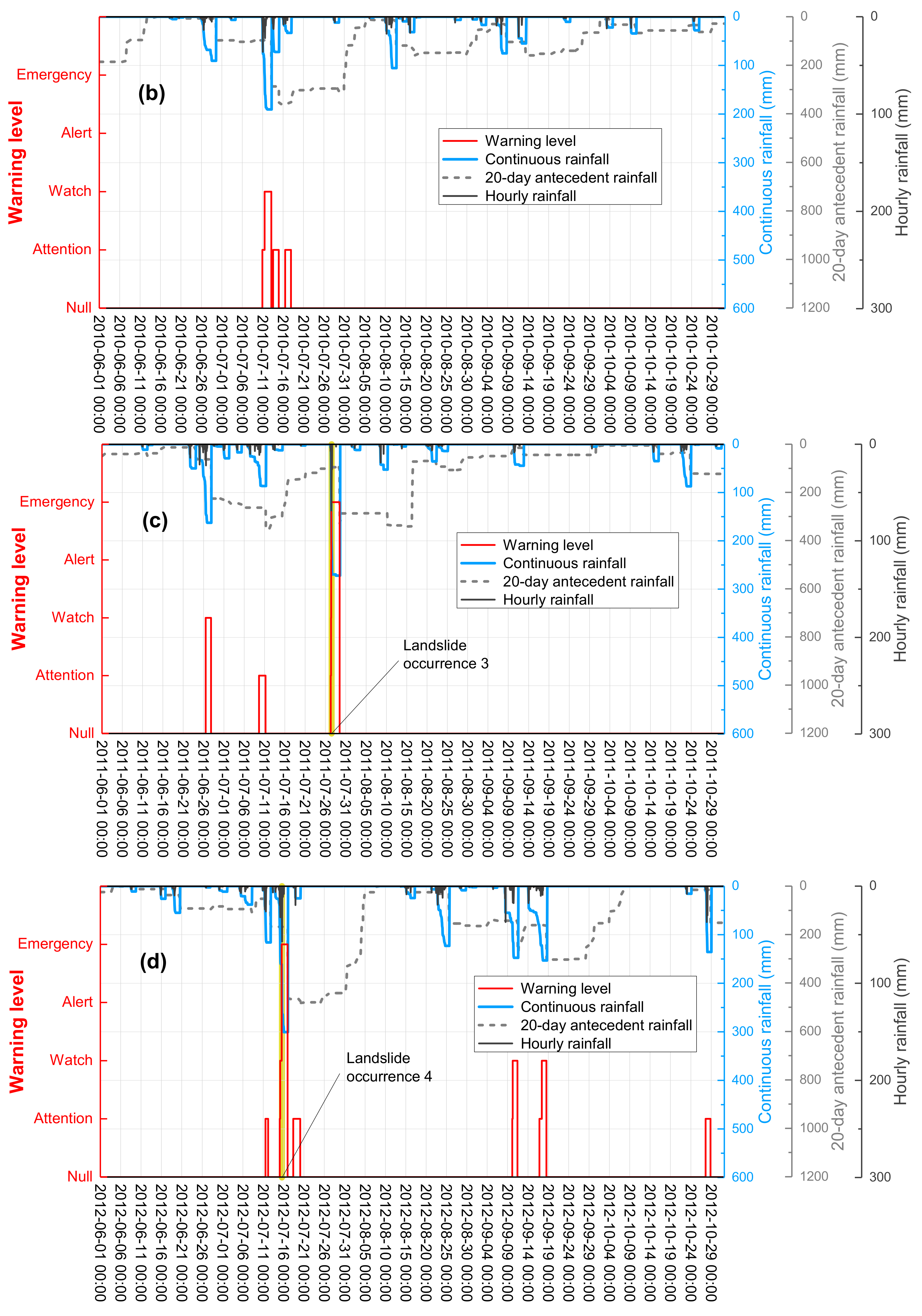
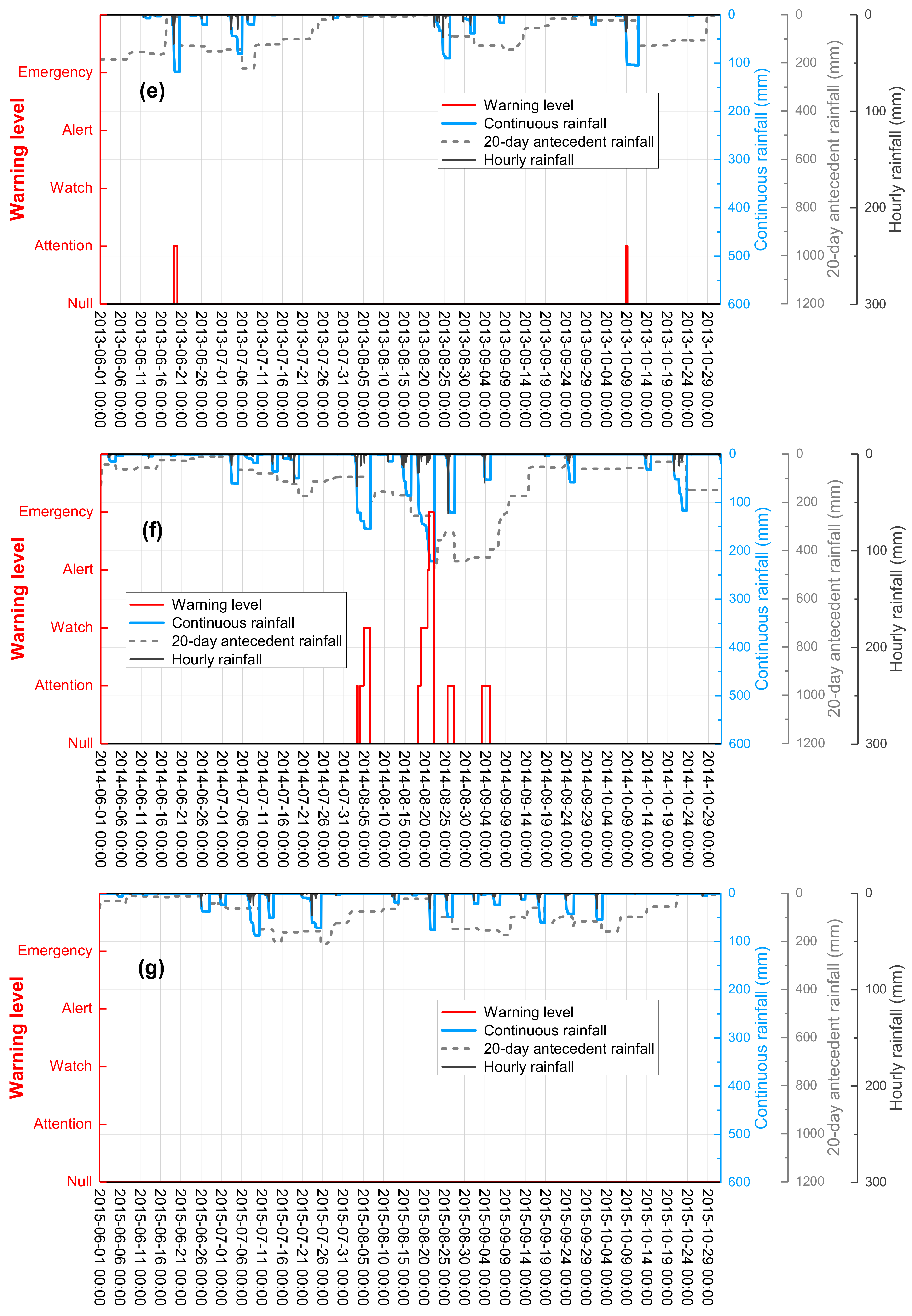
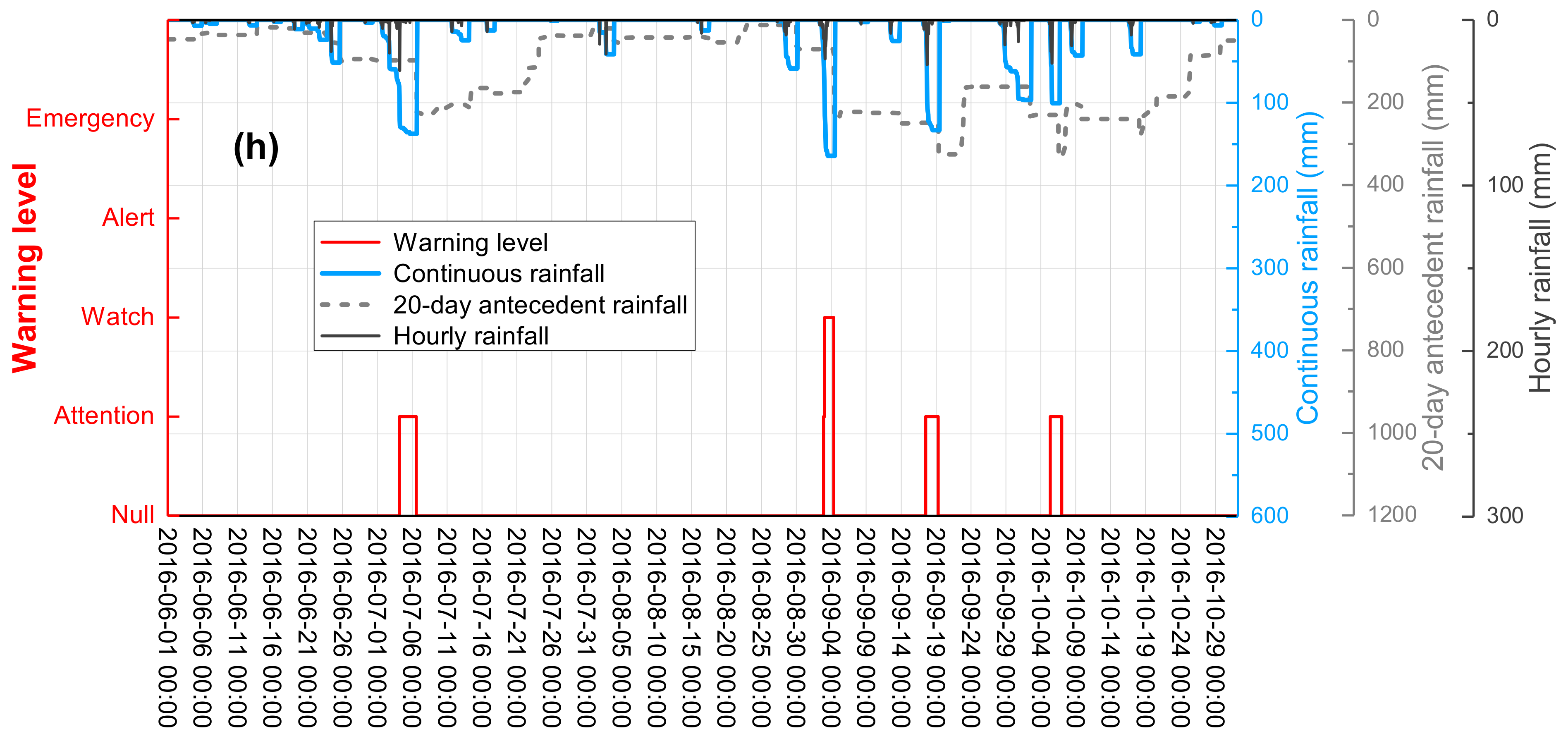
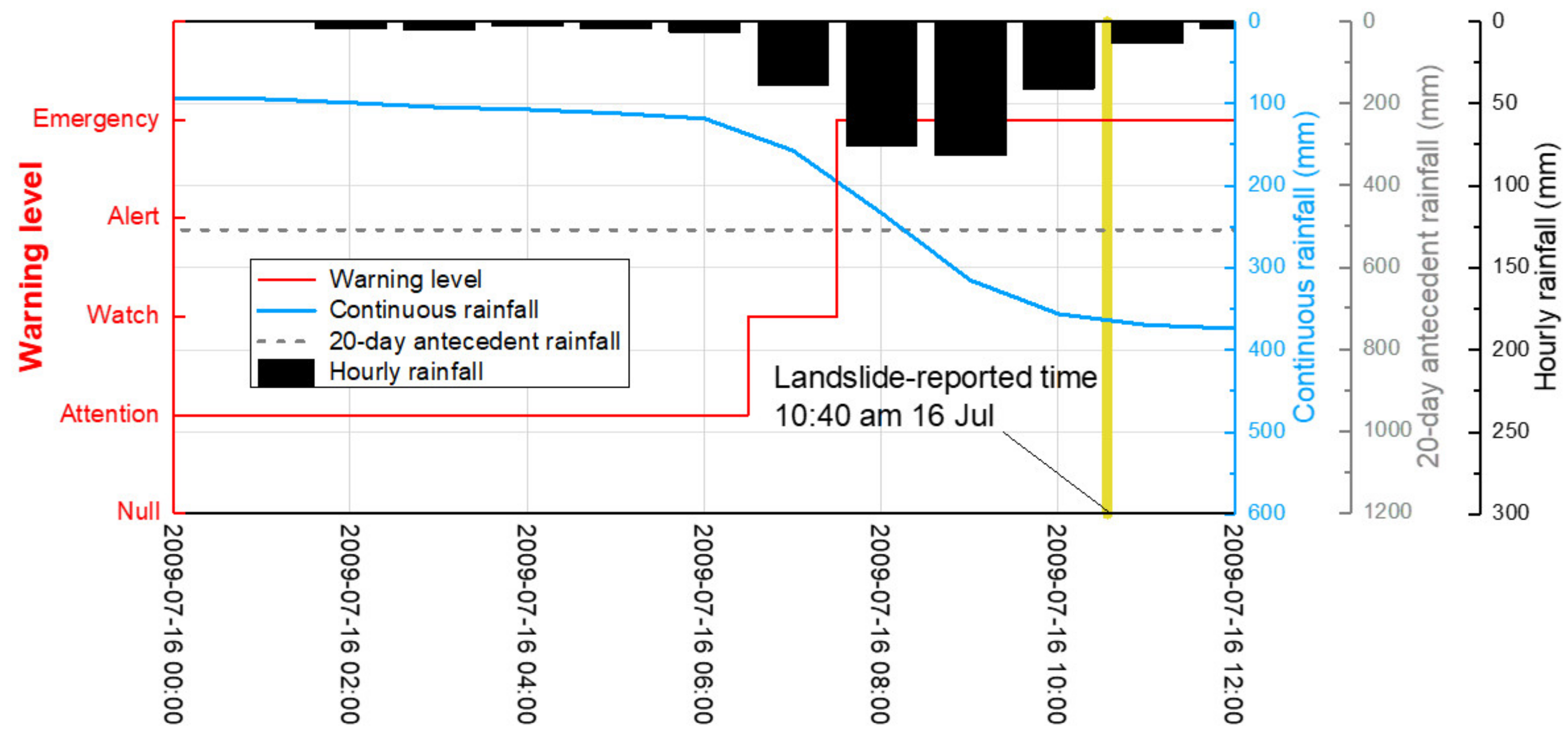
| Category | Specifications | |
|---|---|---|
| Areal management scale | Regional scale (citywide) | |
| Typical landslide type | Rapid shallow landslide and debris flow induced by heavy rainfall. | |
| Hazard evaluation method | Sequential evaluation approach using the following thresholds:
| |
| Input factors |
| |
| Interest in time for hazard evaluation |
| |
| Warning level resolution | Temporal (Update frequency) |
|
| Spatial |
| |
| Occurrence Date | Number of GIS Landslide Data Points | Number of Classified Data Points According to Spatial Precision | ||
|---|---|---|---|---|
| 1st Class | 2nd Class | 3rd Class | ||
| 2 July 1999 | 1 | - | - | 1 |
| 10 September 1999 | 1 | 1 | - | - |
| 14 July 2000 | 1 | - | - | 1 |
| 9 August 2002 | 1 | - | - | 1 |
| 10 August 2002 | 2 | 1 | - | 1 |
| 11 August 2002 | 1 | - | - | 1 |
| 12 September 2003 | 3 | - | - | 3 |
| 6 September 2005 | 2 | - | 1 | 1 |
| 9 July 2006 | 12 | 2 | 1 | 9 |
| 10 July 2006 | 12 | 3 | 9 | - |
| 15 August 2008 | 1 | - | 1 | - |
| 16 August 2008 | 1 | - | 1 | - |
| 7 July 2009 | 13 | 8 | 5 | - |
| 16 July 2009 | 148 | 69 | 55 | 24 |
| 27 July 2011 | 60 | 17 | 22 | 21 |
| 15 July 2012 | 13 | 2 | 10 | 1 |
| 18 August 2014 | 1 | 1 | - | - |
| 25 August 2014 | 41 | 12 | 18 | 11 |
| 4 July 2016 | 2 | 1 | 1 | - |
| 5 October 2016 | 1 | - | 1 | - |
| Total | 317 | 117 | 125 | 75 |
| Landslide Type | Number of Historical Landslide Data Points | Total | |||||||
|---|---|---|---|---|---|---|---|---|---|
| IC Zone 1 | IC Zone 2 | IC Zone 3 | IC Zone 4 | IC Zone 5 | IC Zone 6 | IC Zone 7 | IC Zone 8 | ||
| Slope failure | 4 | 2 | 68 | 60 | 9 | 24 | 17 | 2 | 186 |
| Debris flow | - | 1 | 10 | 18 | 4 | 1 | 2 | - | 36 |
| Date of Landslide | Representative Landslide Occurrence Time (hh:mm) | |||||||
|---|---|---|---|---|---|---|---|---|
| IC Zone 1 | IC Zone 2 | IC Zone 3 | IC Zone 4 | IC Zone 5 | IC Zone 6 | IC Zone 7 | IC Zone 8 | |
| 7 July 2009 | - | - | - | 09:23 | 12:50 | 09:20 | - | - |
| 16 July 2009 | 06:30 P | 06:30 P | 07:50 | 10:40 | 7:00 P | 10:00 | 07:30 | - |
| 27 July 2011 | - | - | 10:14 | 10:20 | - | - | - | - |
| 15 July 2012 | - | 13:00 | 02:30 | 04:00 | 00:10 | - | - | - |
| 18 August 2014 | - | - | - | - | 05:25 | - | - | - |
| 25 August 2014 | - | - | 15:30P | 14:22 | 14:30 P | 16:00 P | 16:00 | 16:00 |
| 4 July 2016 | - | 03:21 | 08:07 | - | - | - | - | - |
| 5 October 2016 | - | - | - | - | - | 10:00 | - | - |
| Mean Lead Time | Annual Expected Total Duration of Warning | Landslide Probability During Warning Event | Landslide Probability at High Warning Levels | Approximate Critical Continuous Rainfall Amount | |||
|---|---|---|---|---|---|---|---|
| Attention | Watch | Alert | Emergency | ||||
| 1 d 8 h | 4 h 25 min | 1 h 43 min | 1 h 10 min | 7 d | 13% | 80% | ~220 mm (small-scale landslides)/ ~310 mm (large-scale landslides) |
© 2020 by the authors. Licensee MDPI, Basel, Switzerland. This article is an open access article distributed under the terms and conditions of the Creative Commons Attribution (CC BY) license (http://creativecommons.org/licenses/by/4.0/).
Share and Cite
Park, J.-Y.; Lee, S.-R.; Kim, Y.-T.; Kang, S.; Lee, D.-H. A Regional-Scale Landslide Early Warning System Based on the Sequential Evaluation Method: Development and Performance Analysis. Appl. Sci. 2020, 10, 5788. https://doi.org/10.3390/app10175788
Park J-Y, Lee S-R, Kim Y-T, Kang S, Lee D-H. A Regional-Scale Landslide Early Warning System Based on the Sequential Evaluation Method: Development and Performance Analysis. Applied Sciences. 2020; 10(17):5788. https://doi.org/10.3390/app10175788
Chicago/Turabian StylePark, Joon-Young, Seung-Rae Lee, Yun-Tae Kim, Sinhang Kang, and Deuk-Hwan Lee. 2020. "A Regional-Scale Landslide Early Warning System Based on the Sequential Evaluation Method: Development and Performance Analysis" Applied Sciences 10, no. 17: 5788. https://doi.org/10.3390/app10175788






